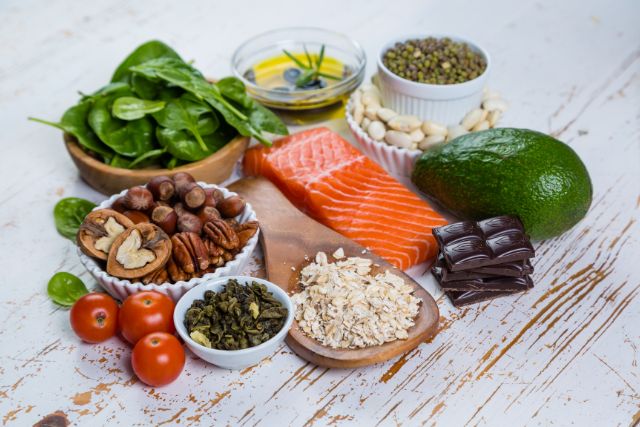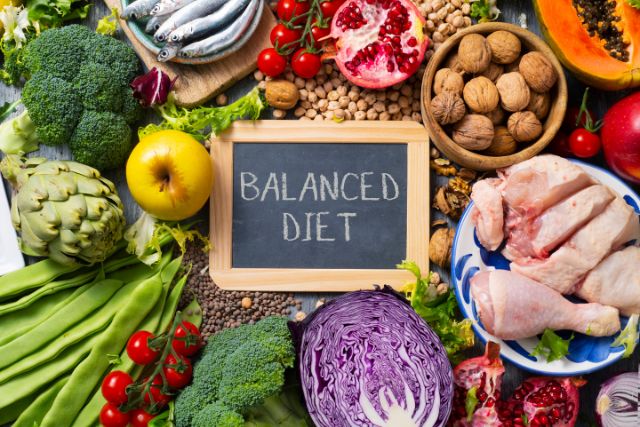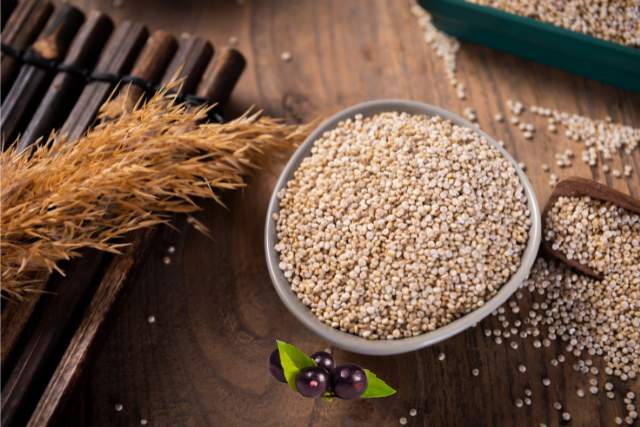Recent Posts
-

- Diabetes-Friendly Nutrition: Smart... 08.12.2024
-

- Nutrition for Chronic... 08.12.2024
-

- Anti-Inflammatory Diet: Food... 08.12.2024
-

- Low-Sodium and Heart-Healthy:... 08.12.2024
-

- Plant-Based Diets for... 08.12.2024
From Acai to Quinoa: The Most Nutrient-Packed Superfoods You Should Be Eating

What is the first thing that springs to mind when you hear the term "superfoods"? Does this imply that it has the potential to provide you superpowers? However, despite our hopes, this does not seem to be the case.
When we speak about "superfoods," we're referring to foods that provide an abundance of health advantages for a comparatively low number of calories. They are an excellent source of a variety of nutrients, including vitamins, minerals, and anti-oxidants. Foods that have an extremely high nutritional density are referred to as "superfoods." This indicates that they supply a significant quantity of nutrients while having an extremely low calorie content.
It is important to note that the term "superfoods" is plural; this indicates that there is more than one kind of "superfood," and that we should constantly strive to eat a balanced diet. Consuming foods classified as "superfoods" is synonymous with stocking our diets with foodstuffs that provide the greatest potential advantages to our health.
In addition, the ones that matter the most include quinoa, beans, almonds, berries, salmon, and broccoli. The term "superfood" refers to foods that are very rich in nutrients such as vitamins, minerals, fiber, and other phytochemicals. They often have a high concentration of phytonutrients as well as antioxidants.
In specifically, superfoods are foods that are high in a variety of nutrients, including the following:
Antioxidants are naturally occurring molecules that shield cells from harm and have been linked to a reduced chance of developing cardiovascular disease, cancer, and other disorders.
Minerals are necessary elements that enable your body function at its greatest potential. Some examples of minerals are calcium, potassium, iron, and others.
Vitamins is preferable to get these organic components from the consumption of natural foods, such as superfoods, as opposed to taking vitamin pills.
Fiber helps lower cholesterol, protect against heart disease, and keep glucose levels under control in those who have type 2 diabetes.
Flavonoids are powerful antioxidants that may reduce inflammation and protect cells from cancer. Flavonoids, which were formerly known as vitamin P, are found in plants.
The consumption of healthy fats, such as monounsaturated and polyunsaturated fats, sometimes known as "good fats," may help reduce cholesterol levels and reduce the risk of cardiovascular disease and stroke.
Now that we are aware of the benefits that we may get from consuming Superfoods, let's have a look at a list of foods that have the potential to be classified as such. It's possible that you’ll never learn that your go-to dish is really a nutritional powerhouse. Let's find out!
Avocados
In addition to being an integral part of one of the most popular items served at brunch these days, avocado toast, the fruit alone provides a plethora of nutrients that are cause for celebration.
The United States Department of Agriculture (USDA) reports that one-half of an avocado has 29 milligrams (mg) of magnesium, which is equivalent to around 7 percent of the daily value. A magnesium shortage is related with an increased risk for type 2 diabetes. Magnesium is involved in the regulation of both blood pressure and blood sugar, and a lack of magnesium is connected with this increased risk.
Pomegranate
It may seem odd to consider fruit to be fashionable, but if you've seen the proliferation of "bowl foods" at cafes and restaurants, you'll know that exotic fruits such as acai berries, dragon fruit, mango, and pomegranate are absolutely in style right now. Due to the high levels of nutrients and other beneficial compounds that they contain, exotic fruits have been hailed as "superfoods" for a very long time.
According to an article that was published in May of 2018, research indicates that pomegranates, for example, may improve heart health and make an excellent candidate for the development of dietary supplements that might prevent cardiovascular disease.
Berries
Although blueberries are at the top of almost every "superfoods" list, the designation "superfood" may be appropriately bestowed upon virtually any edible fruit. Blackberries, cranberries (the fresh version, not the dried variety), strawberries, and raspberries, to mention a few, are low in calories, rich in fiber, and packed full of antioxidants that help fight against cancer-causing free radicals. The nutritional content of other berries, such as blueberries and cherries, may vary widely.
Particularly high in anthocyanin pigments are blueberries, which not only contribute to their vibrant color but also serve as potent antioxidants and may reduce the likelihood of developing diabetes, cardiovascular disease, and neurodegenerative disorders such as Alzheimer's. Blueberries contain a high anthocyanin content.
Broccoli
Cruciferous vegetables are vegetables that have petals that seem to be in the shape of a cross. These vegetables are celebrated for their many health advantages, including a reduced chance of developing cancer and protection against heart attacks and strokes. Cruciferous vegetables including broccoli, Brussels sprouts, bok choy, cauliflower, cabbage, and maca are all rich in fiber. Other cruciferous vegetables include maca. According to the findings of previous studies, not only is fiber beneficial for your health, but it also helps you feel full for a longer period of time, which may facilitate weight reduction.
Seafood
Fish is a great source of protein and is rich in good fats, in contrast to many other animal products that are high in saturated fats, such as red meat and processed meats, which might increase the risk of developing heart disease. It has been shown that omega-3 fatty acids, namely the kind that may be obtained from seafood such as fish, are very advantageous to the human body. In general, omega-3 fatty acids may help alleviate symptoms of depression, reduce the risk of heart attack and stroke, and contribute to the overall growth and development of infants.
Onions, Garlic
Allium vegetables, such as chives, onions, garlic, leeks, and others like them, may taste unpleasant to eat (and some of them even drive us to tears), yet they provide significant health advantages. In addition to that, they are really tasty. Garlic has both antibacterial and antiviral effects, and it was formerly thought to protect people from the "evil eye."
According to recent research, foods that contain allium compounds may help reduce the risk of developing cancer. In particular, garlic may be beneficial for patients who already have diabetes, high cholesterol, or high blood pressure.
Mushrooms
Mushrooms have been revered as a "superfood" for many years and continue to play an important role in the practice of traditional Chinese medicine, where they are believed to purify the body and extend life. Mycotherapy, which refers to the practice of using mushrooms as medication, is utilized as a supplemental treatment for breast cancer. Researchers have spent a significant amount of time studying the antibacterial, antioxidant, and anti-inflammatory properties of mushrooms.
Seeds and Nuts
Although various nuts are said to have distinct health benefits, such almonds for heart health, cashews for cognitive function, and Brazil nuts for cancer prevention, all nuts are an excellent source of fat, fiber, and protein. It is simple to add seeds like flaxseeds, chia seeds, and hemp seeds into your diet, and doing so will reward you with an abundance of vitamins and minerals.
Dark, Leafy Greens
According to nutritionists like as Wolfram, in general, the deeper the color of a vegetable, the more nutrients it contains. The chlorophyll that gives dark, leafy greens like arugula, kale, collard greens, spinach, lettuce, and Swiss chard their bright hues also helps keep plants healthy. Additionally, the dietary fiber that is included in dark greens has been shown to reduce the risk of colon cancer.
Citrus Fruits
Due to the high levels of fiber and vitamin C that they contain, citrus fruits have been heralded as "superfoods." Citrus fruits like grapefruit, oranges, lemons, and limes have a taste that is both sweet and acidic, and they are also low in calories and rich in water content.
Kombucha and Kimchi
Fermented foods are another category that is popular right now. If you have a jug of fizzy, somewhat alcoholic tea taking up prime real estate in your refrigerator, then you are already aware of this trend. Fermented (or preserved) foods like kimchi, kombucha, kefir, miso, sauerkraut, and yogurt are excellent sources of the beneficial bacteria known as probiotics.
The human body generates millions of probiotic bacteria, which are referred to as "healthy" bacteria. Collectively, these bacteria are referred to as the microbiome. Probiotics have been linked to a variety of health benefits, including the maintenance of a healthy gut microbiota and the reduction or elimination of illness risk. Supplements as well as meals, the majority of which are fermented, may be sources of probiotics. For instance, the live bacteria found in yogurt have been shown to lower the chance of developing chronic inflammatory disorders.
Chocolate with a dark hue
Dark chocolate, as opposed to its milk and white chocolate siblings, which are sweeter, may have positive effects on one's health. Cacao, which is found in dark chocolate, is loaded with antioxidants, which have been linked to a potential role in the prevention of cancer, as well as heart health and weight reduction.
Sweet Potatoes
There's a solid reason why sweet potatoes have been considered a superfood for such a long time. Root vegetables such as carrots, beets, parsnips, potatoes, and yams have been sustaining human existence for hundreds of years — and through many a severe winter — because to their ability to store large amounts of energy.
Root vegetables are an excellent source of nutrition, are simple to cultivate, and have an incredibly long life cycle (some varieties may survive for months if they are kept correctly). In addition, they are filled with beneficial carbohydrates and starches that offer energy. Because of their anti-inflammatory, antioxidative, and antibacterial qualities, sweet potatoes have been indicated in a review of the research that has been conducted on them as a possible factor in the prevention of diabetes, obesity, cancer, and other diseases and disorders.
Legumes and other Beans
When it comes to superfoods, beans and other members of the legume family have the power of protein derived from plants. Beans and other legumes, in contrast to the food that comes from many different animal sources, are low in saturated fats, which are known to elevate cholesterol levels and contribute to the development of heart disease. Additionally, beans and legumes provide health advantages that are not present in animal products.
Research has shown that the high quantities of fiber and vitamins that are contained in beans, such as chickpeas, edamame, lentils, and peas, may assist with weight reduction and regulate blood sugar levels. There are hundreds of different varieties of beans that are as densely packed with nutrients.
Disclaimer: The information provided in this article is for general information purposes only. All information in this article is sourced from other websites, and we do not represent any rights regarding the contents and information on the site. All rights belong to their original owner.
Sources:
- Superfoods: Health benefits, uses, and risks (medicalnewstoday.com)
- What Is a Superfood, Anyway? – Cleveland Clinic
- What Superfoods Are, and Why We Should Be Eating Them | Mom.com
- 15 of the Most Powerful Superfoods | Everyday Health





